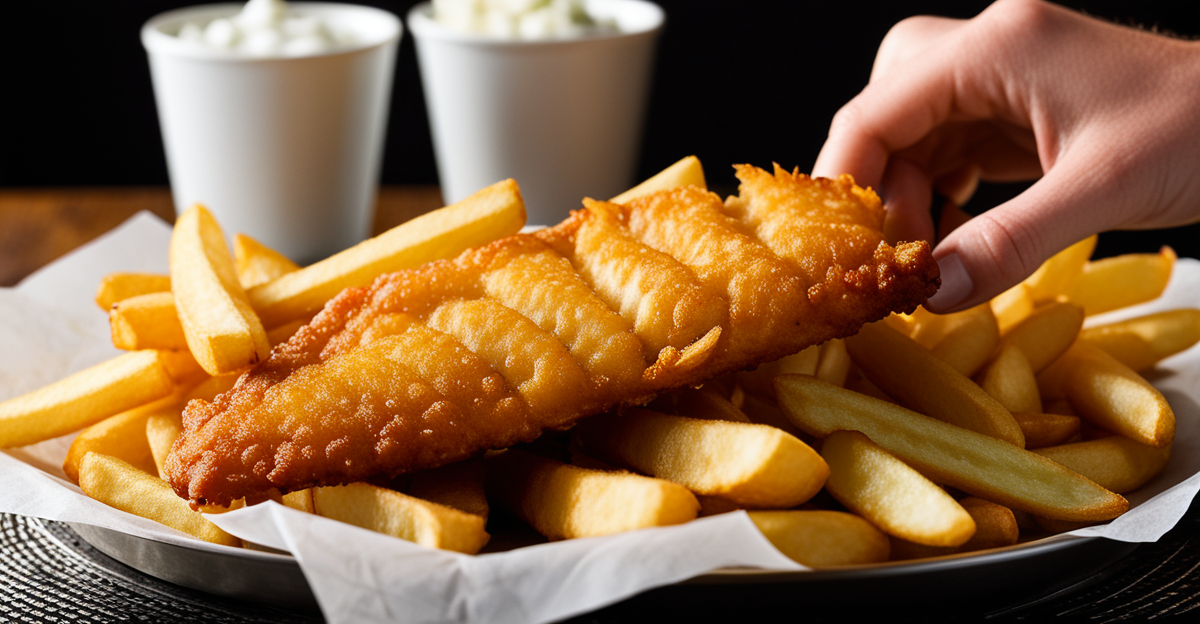Essential Ingredients and Selection for Authentic British Fish and Chips
Choosing the right fish is crucial for authentic British fish and chips. Traditionally, cod and haddock are the preferred options due to their mild flavor and flaky texture. When selecting fish, look for freshness and sustainable sources, ensuring the fish is firm, moist, and free from any off smells. Sustainable choices not only support ecological balance but also tend to offer higher quality.
For the chips, the choice of potatoes dramatically impacts the final dish. Starchy potatoes like Maris Piper or King Edward are favored because they produce fluffy interiors with crisp exteriors after frying. Properly selecting chip potatoes contributes to authentic texture and taste.
In the same genre : What are the steps to crafting a homemade treacle tart?
Freshness in both fish and potatoes cannot be overstated; authentic ingredients form the foundation of great fish and chips. Locally sourced produce, when possible, enhances flavor and maintains culinary tradition. Selecting high-quality, fresh fish alongside right, starchy potatoes guarantees a more genuine and satisfying British fish and chips experience.
Essential Ingredients and Selection for Authentic British Fish and Chips
Selecting the right ingredients is crucial to crafting authentic British fish and chips. The primary focus should be on choosing fish known for their texture and flavor. Traditional British fish options often include cod and haddock, prized for their flaky white flesh and mild taste. Sustainability is also important; many experts recommend opting for responsibly sourced fish to ensure freshness and environmental care.
Topic to read : How can you make a rich and savory beef stew with dumplings?
When selecting fish, freshness is paramount. Fresh fish will have a clean, sea-like smell and firm flesh that bounces back when pressed. This quality directly impacts the final taste and texture after frying.
Equally important are the chip potatoes. The perfect chips come from starchy varieties like Maris Piper or King Edward, which produce fluffy interiors and crispy exteriors when fried. Proper selection of potatoes means looking for tubers free from green spots or sprouting to ensure authenticity in texture.
Freshness extends beyond fish and potatoes. Using authentic ingredients guarantees the traditional flavors and mouthfeel that define classic fish and chips. By focusing on these essentials—traditional British fish options, sustainable choices, and perfect chip potatoes—you lay the foundation for a truly authentic dish.
Crafting the Classic Crispy Batter
A fish batter recipe that delivers the iconic crispy texture is essential for authentic British fish and chips. The batter should be light yet crunchy, enveloping the fish perfectly without overpowering its delicate flavor. Key ingredients typically include plain flour, cold sparkling water or beer, and a pinch of baking powder to add airiness.
Temperature and mixing techniques are pivotal to success. Using cold water or beer helps keep the batter light, while careful mixing avoids overdeveloping gluten, which would lead to toughness. Resting the batter for about 30 minutes enhances texture by allowing the flour to hydrate fully.
Achieving superior crispy batter involves controlling frying conditions. The oil must be preheated to around 180°C (356°F); too cool and the batter absorbs oil, becoming soggy, too hot and it burns quickly. Double frying fish is rarely used, but a single quick, steady fry ensures the batter puffs crisply and locks in moisture.
British chefs often recommend adding a small amount of cornflour to the batter mix for extra crunch, and some swear by incorporating a tiny pinch of salt or mustard powder to boost flavor subtly. Light, bubbly batter results from these techniques, melding tradition with science for perfect fish and chips every time.
Essential Ingredients and Selection for Authentic British Fish and Chips
Selecting fish hinges on traditional British fish options like cod and haddock, valued for their flaky white flesh and mild flavor. These species excel in delivering the authentic texture crucial for classic fish and chips. Sustainability is equally vital; choosing responsibly sourced fish ensures both freshness and environmental stewardship. This means looking for fish that presents firm flesh and a clean, sea-like aroma, which confirms freshness and lays the groundwork for a flavorful, tender bite after cooking.
When selecting fish, freshness directly influences the taste and mouthfeel, so prioritize fish that bounces back when pressed and is free of any off-putting odors.
For chip potatoes, choosing the right variety is indispensable for authenticity. Starchy potatoes such as Maris Piper or King Edward produce the characteristic fluffy interior and crisp exterior desired in British chips. Avoid potatoes with green spots or signs of sprouting to maintain quality.
Recognizing the importance of freshness and proper sourcing across both fish and chip potatoes is key. Together, these careful selections uphold the integrity and authenticity of British fish and chips, ensuring a dish that honors tradition and delights the palate.
Traditional Chip Preparation Methods
Achieving authentic British chips begins with careful potato preparation. Start by cutting chip potatoes into thick, uniform strips to ensure even cooking. Soaking the cut potatoes in cold water for at least 30 minutes removes excess starch, which prevents chips from sticking and helps develop crispiness during frying.
The classic technique to perfect chip texture is double frying. First, blanch the chips at a lower temperature (around 130°C) until soft but not coloured. This step cooks the interior fully. After draining and cooling, fry again at a higher temperature (about 180°C) to create a golden, crunchy exterior. This method reduces sogginess and guarantees a pleasing contrast between fluffy inside and crisp outside.
Homemade chips benefit from this process, offering better control over texture than pre-packaged options. Avoid overcrowding the frying vessel during both fry stages to maintain consistent temperature, which is critical to authenticity. Using starchy potatoes like Maris Piper enhances crispness, reinforcing the traditional British experience.
By mastering these preparation steps—cutting, soaking, blanching, and double frying—you ensure the chips are authentic in both flavor and texture, supporting the classic standard of British fish and chips.
Traditional Chip Preparation Methods
Perfect British chips begin with careful preparation of potatoes. Start by cutting chip potatoes into uniform strips to ensure even cooking. Soaking these raw-cut potatoes in cold water for at least 30 minutes removes excess starch, which is key to preventing chips from sticking and turning gummy during frying.
Blanching is a crucial step to achieve that sought-after classic chip texture. It involves frying the chips at a lower temperature (around 130°C/266°F) just until they are softened but not browned. This step cooks the interior, setting the fluffy texture inside.
The secret to golden, crisp chips lies in double frying. After blanching, drain and cool the chips before frying them again in hotter oil (around 180°C/356°F). This second fry crisps the exterior beautifully, resulting in a satisfying crunch while maintaining a tender, fluffy interior.
Avoiding sogginess requires controlling frying times and temperatures precisely. Overcrowding the fryer lowers oil temperature, causing chips to absorb excess oil and lose crispness. Using fresh oil and draining cooked chips on paper towels also helps maintain ideal golden crispiness.
This method—cutting, soaking, blanching, then double frying—creates authentic British chips with the perfect texture loved in traditional fish and chips.
Essential Ingredients and Selection for Authentic British Fish and Chips
Selecting fish for authentic British fish and chips means prioritizing traditional British fish options like cod and haddock. These fish are celebrated for their flaky white flesh, mild flavor, and ability to hold up well during frying. When selecting fish, freshness is key—look for firm flesh that springs back when pressed and a clean, sea-like aroma. Sustainable options are increasingly important, ensuring responsible sourcing without compromising quality.
For the chip potatoes, starchy varieties such as Maris Piper and King Edward are essential for achieving the classic fluffy interior and crispy exterior. Selecting potatoes without green spots or signs of sprouting preserves both taste and texture. Freshness applies here too; properly stored potatoes improve the final chip quality dramatically.
Focusing on authentic ingredients ensures the dish meets expectations of authenticity both in taste and texture. Each choice—from fish variety to potato selection—affects the final product. By carefully selecting fish and chip potatoes, cooks honor the cherished tradition of British fish and chips, delivering the characteristic flavors and satisfying mouthfeel that define this iconic meal.
Essential Ingredients and Selection for Authentic British Fish and Chips
When selecting fish for authentic British fish and chips, traditional British fish options like cod and haddock remain the gold standard. Their flaky white flesh and mild taste offer the ideal texture and flavor that defines the dish. Sustainability in sourcing is crucial to both environmental responsibility and ensuring fresh, high-quality fish. Fresh fish should have a firm texture that springs back when touched and a clean, sea-like aroma without any off-putting smells.
Equally important is the choice of chip potatoes. Starchy varieties such as Maris Piper or King Edward are preferred for their ability to yield fluffy interiors with crisp exteriors after frying. Selecting potatoes free from green spots or sprouting ensures consistency and authenticity in the final product. The freshness of both the fish and potatoes directly impacts the overall texture and taste, making careful ingredient selection essential.
Prioritizing authentic ingredients helps preserve the heritage and flavors that make British fish and chips unique. By focusing on traditional British fish options, sustainable sourcing, and the right chip potatoes, you build the foundation for a truly authentic fish and chips experience.
Essential Ingredients and Selection for Authentic British Fish and Chips
Selecting fish is foundational to authentic British fish and chips. The traditional British fish options of cod and haddock are indispensable due to their mild flavor and tender, flaky texture. When selecting fish, freshness is crucial; press the flesh gently—it should bounce back, indicating firmness—and check for a clean, sea-like aroma to guarantee quality. Sustainability also plays a role: responsible sourcing not only supports the environment but often ensures better-tasting fish.
For chip potatoes, choosing starchy varieties such as Maris Piper or King Edward is essential. These potatoes provide the ideal balance, yielding fluffy interiors and crisp exteriors—hallmarks of authentic British chips. Avoid potatoes showing green spots or sprouting, as these can affect both flavor and texture. Soaking and proper storage further enhance freshness.
Emphasizing freshness and authenticity when selecting fish and chip potatoes directly affects the final dish’s quality. The careful balance of these ingredients upholds the dish’s renowned texture and flavor, reflecting the heritage of British fish and chips faithfully. Recognizing these selection principles elevates your preparation, ensuring each element contributes to the meal’s authenticity.









